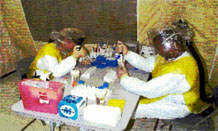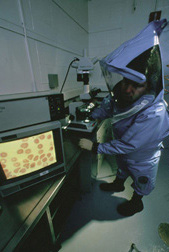 |
 |
 |

Department of Defense
U.S. Army Medical Research
Institute of Infectious Diseases (USAMRIID)
Video Networks, Inc. has supported the Pentagonís counter biological
warfare agencies since 1996. Their efforts have resulted in both permanent capabilities at USAMRIID
and temporary event-centered support for The Armed Forces Epidemiological Board (AFEB).
Most recently, VNI was tasked with upgrading the training capabilities in the Dalrymple Conference Room at Fort
Detrick. As a result of design expertise, the space is now able to provide a flexible environment for
a variety of meeting styles. Scientific panels can meet with state-of-the-art wireless transcription
technology and Subject Matter Experts are capable of presenting their latest findings, both locally and
to related organizations through video conferencing links. Standard briefings and even Christmas parties
are easily accommodated with the innovative architecture VNI has implemented.
Military Surface Deployment
and Distribution Command (formerly Military Traffic Management Command, MTMC)
Video Networks, Inc. performed its first work at SDDC as a
sub-contractor to Navy SPAWAR SYSCOM. SDDC has subsequently issued several contracts directly
to VNI for additional enhancements and corrections of work performed by others. During Operation
Enduring Freedom, VNI was tasked with upgrading six special purpose rooms at SDDC, providing them
with video teleconferencing and collaboration capabilities.
The projectís scope and timeline were aggressive, and required the highest audio and video
expertise. As a result, VNI leveraged expensive equipment so that several rooms could ďshareĒ
hardware across networks, thus maximizing return on investment and providing access to a wider
range of activities.
Civilian Agencies
Internal Revenue Service
Video Networks, Inc. was tasked with enhancing the Internal
Revenue Serviceís Business Systems Modernization Office (BSMO) Management Information Centersí
(MIC) existing capabilities. The ultimate goal of the upgrades was to provide MIC with increased
multi-site collaboration in order to eliminate the travel burden.
In order to accomplish this task, Video Networks, Inc. constructed a unique configuration of
off-the-shelf hardware that integrated the operation of the visual communication system with
the manipulation of the data using IRS standard software applications. VNI designed the user
interface for both beginners and power users. From this touch screen, users are able to control
the entire system with just a few easy steps. The outcome of this re-configuration was that a
single operator could control all the rooms during a meeting, thus eliminating any staff increases
to support the technology.
As a result, VNI was able to provide MIC with a command center equipped with optimal technical
analysis, deliberation, communication, and meeting and conferencing capabilities.
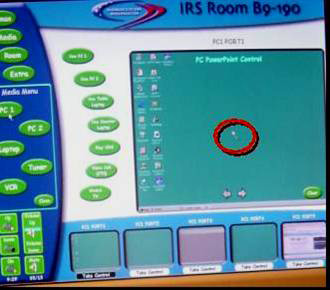
Homeland Security
United States Coast Guard
Video Networks, Inc. performed the first major upgrade for the
Coast Guard, Commandantís Situation Room (CSR) in 1996. Most recently, The USCG enlisted
VNIís expertise to support major exercises and provide updated technologies and advanced
communications capabilities in order to improve government and industryís ability to respond
to national disasters and direct attacks on our country. VNIís solution equipped the CSR with
multi-site video teleconferencing, which provided instantaneous, face to face communications
and established a first time ever simultaneous link between the Commandant and Congressional
staff members at Coast Guard Headquarters and other key organizations.
As a result of VNIís efforts, the Coast Guard's National Response team is prepared to respond
to any major emergency for which its participation is required.
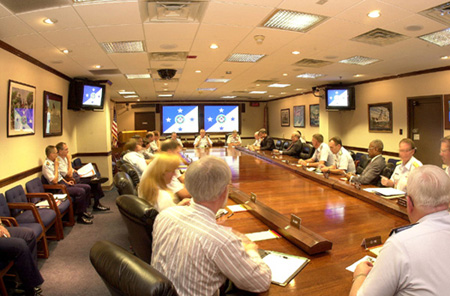
U.S. Coast Guard Photo by Telfair H. Brown
Law Enforcement
The Bureau of Alcohol, Tobacco
and Firearms
The Bureau of Alcohol Tobacco and Firearms (ATF) visual communications
system supports the Critical Incident Management Support Team (CIMST) by providing a high degree of
situational awareness. In order to successfully accomplish this, ATF looked to Video Networks, Inc.
to furnish them with a complete facility design, from lights and furniture to status displays and collaboration
technology. VNI was also tasked with upgrading the visual communications systems and system capabilities in
INTEL and the Directorís and Assistant Directorís conference rooms. These rooms were given similar
capabilities, as well as smaller projection systems that support independent audio-visual needs and the
capability view video feeds from the other rooms and share in video teleconferencing. In addition to this,
VNI took on the Washington Field Division and equipped them with two projection systems with similar sources
for display that includes numerous computer workstations throughout the room and video teleconferencing capabilities.
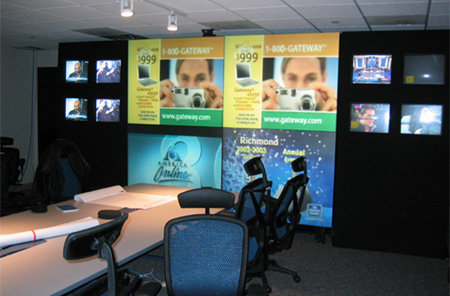
World Cup Soccer
For the 1994 World Cup Soccer Event, Video Networks, Inc. was
tasked with the design, procurement, integration, installation, and end-user support for six Joint
Operations Centers (JOC). Due to the overwhelming increase in population during the World Cup
events, city-level law enforcement and emergency management capabilities were rendered inadequate.
As a result, local authorities and Department of Defense personnel needed to have a complex center
that combined sanitized intelligence reports, surveillance cameras located throughout the cities, police
and fire radio communications, and military command and control, to enable effective oversight by elected
officials. Video Networks, Inc. was enlisted to accomplish this feat. The contract was awarded to them
only 60 days prior to the first game.
In order for their plan to succeed, VNI had to design the user interfaces to allow operation by local
law enforcement personnel, who had little experience in sophisticated command centers. In spite of the
short period of time, all six centers were online by the time the first game was played. Local law enforcement,
local fire, CIA, State Department, DOD and civilian elected officials were able to work seamlessly for the
duration of the games.
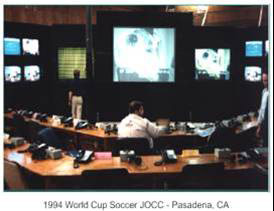
Commercial
National Geographic
Video Networks, Inc. was tasked with the modification of existing visual
communications housed in the Executive Collaboration Room of National Geographic Headquarters. Keeping their
customers needs in mind, VNI created a flexible space where the Chief Executive Officer and high-level
management could meet to discuss projects and plans using versatile and easy to use AV technology. VNI
delivered the design, hardware, installation labor, cabling, and documentation that produced a consolidated
control system with which meetings could be recorded and posted on the intranet or burned to a DVD for future
or external reference.
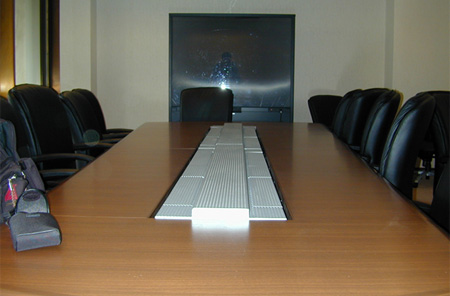
HBO
HBO contacted Video Networks, Inc. to upgrade their Large Screening
Room, which is used to host press events and other high profile functions by combining film, digital
video, and live talent. The room was originally intended to support only film projection, but recently,
electronic presentations of both video and computer sources have increased in frequency of use.
The original system evolved over time without a master design, and much of the equipment was installed
where it would fit, not where it belonged. This created a system that was all but impossible for a single
person to operate and deliver an event.
VNI used their expertise to upgrade the system to a level that provided support for current requirements.
Upon completion, a single operator was able to control video, audio, and lighting from a single location
in a professional fashion.
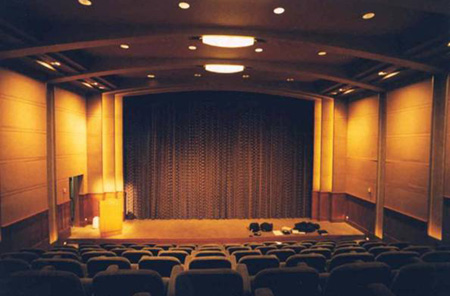
|





